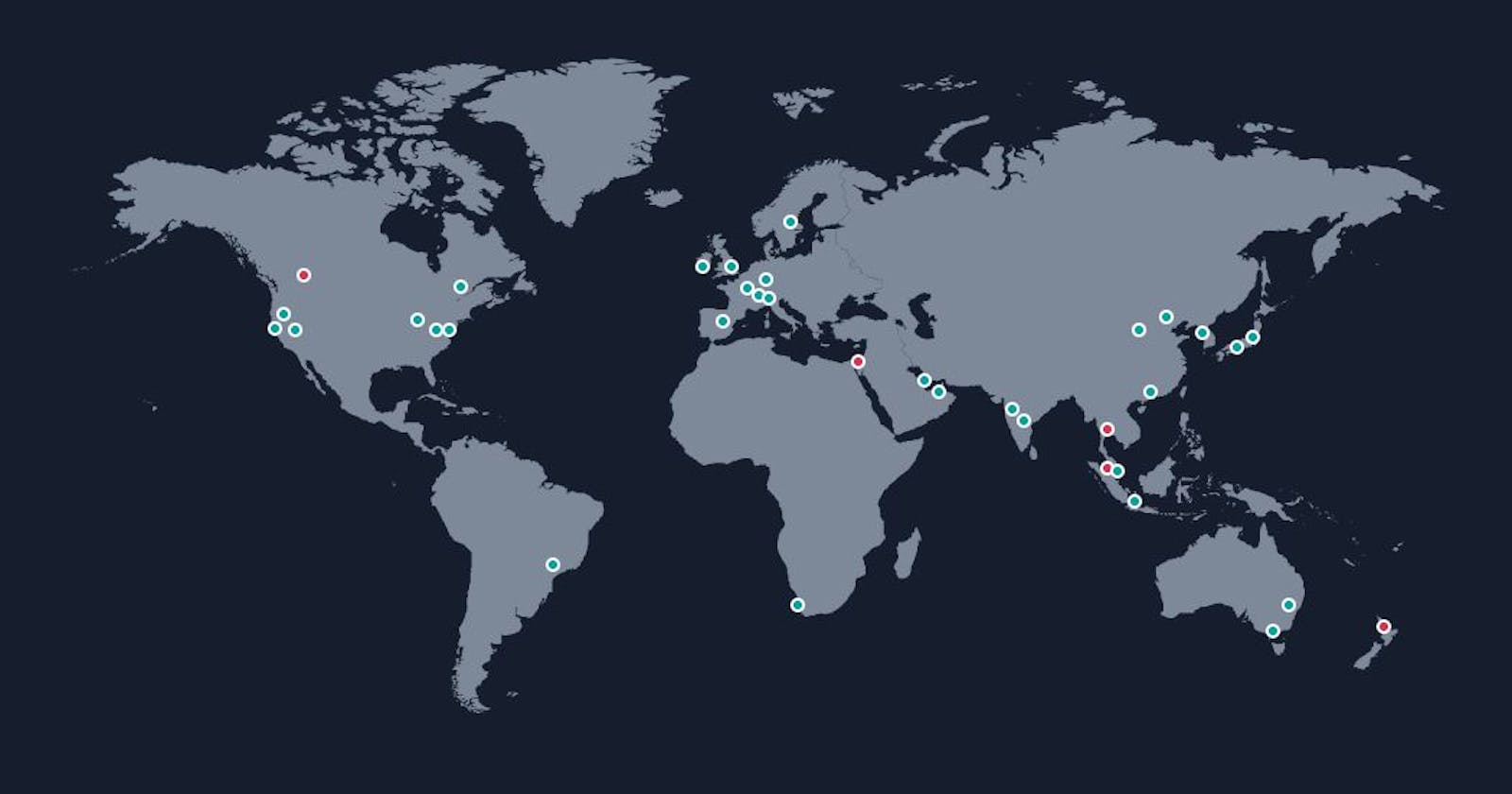Decoding AWS's Global Setup: Regions, Availability Zones, Edge Locations and Service Scopes
Navigating AWS's Geographic Landscape and Service Dimensions
Table of contents
Introduction
Amazon Web Services (AWS), a leader in the cloud computing industry, offers a global infrastructure that ensures high availability, scalability, and fault tolerance. In this blog, we'll dive into the core components of AWS's global infrastructure, focusing on regions, Availability Zones (AZs), Edge Locations and the scope of services.
Amazon Web Services' Global Network
The backbone of AWS Cloud is its global setup of AWS Regions and Availability Zones. Each Region holds multiple Availability Zones, which house separate data centers with backup power, networking, and connectivity for top-tier availability and scalability.
According to the latest data, AWS has 102 Availability Zones within 32 geographic Regions, 400+ Edge locations and 13+ Regional Edge Cache locations with which AWS serves billions of users worldwide. This structure enables the hosting of Amazon Services globally, enhancing speed, availability, and cost-effectiveness.
Aws Regions and availability Zones

Regions
AWS Regions are physical locations around the world where Amazon Web Services operates data centers. Each AWS Region is a separate geographic area and is designed to be isolated from the others. Regions help customers choose the best location for their data and applications based on factors like latency, compliance requirements, and data residency.
Each Region must have at least 2 Availability zones, isolated from each other.
Available Zones
An AWS Region is made up of multiple Availability Zones, which are essentially isolated data centers within that Region. Each Availability Zone is equipped with redundant power, networking, and connectivity. They are designed to provide high availability and fault tolerance, allowing you to run applications that are more reliable and scalable than would be possible from a single data center.
Edge Locations
Edge Locations are AWS data centers strategically positioned worldwide to cache and store content closer to users, ensuring the lowest possible latency for service delivery. This optimization reduces data travel distance, resulting in faster load times and improved user experiences.
Choosing Right AWS Region
When selecting the appropriate AWS Region for hosting applications and workloads, there are four key factors that users should take into account: compliance, Price, Latency and Service availability.
Compliance
Ensure that the chosen AWS Region aligns with regulatory and compliance requirements relevant to your industry and location. Different regions might have varying data protection and privacy regulations. If
Price
Evaluate the cost implications of hosting in different regions. Pricing can vary based on factors like data transfer, storage, and compute resources. Choose a region that offers the most cost-effective solution for your needs.
Latency
Consider the geographical location of your users and the data's source. Select a region that minimizes network latency, ensuring optimal performance and responsiveness for your application.
Service Availability
Assess the availability of the AWS services you require in each region. While most services are available across regions, some might have variations in features or availability. Choose a region that provides the necessary services to meet your application's requirements.
Service Scopes in AWS
AWS provides users with the flexibility to deploy resources at three distinct levels: Availability Zone (AZ), Region, and Global. This choice of deployment scope has significant implications for the architecture, availability, and performance of your applications and services.
Region Scoped Services
Region-scoped services are deployed across an entire AWS region, streamlining the process by allowing users to select a specific region as their deployment destination (no need to select a zone). AWS steps in to manage crucial aspects such as data durability and availability, effectively alleviating users' concerns related to these factors.
Examples: Amazon S3, AWS Lambda, Amazon RDS.
Availability Zone Scoped Services
AZ-scoped services in AWS let users deploy resources within a specific Availability Zone in a chosen region. This enhances data durability and availability within that zone. However, users must plan for redundancy and failover to ensure seamless operations if the chosen zone experiences issues.
Examples: Amazon EC2 instances, and Amazon EBS Volumes.
Global Services
Global services shine in scenarios requiring wide accessibility. Deployed globally across multiple AWS regions, these services serve users across diverse locations. AWS manages these services, ensuring seamless operations and availability worldwide. This is achieved by routing users to nearby edge locations, reducing latency for an improved experience.
Examples: Amazon CloudFront, Amazon Route 53 (DNS), AWS Identity and Access Management (IAM).
Ensuring High Availability and Resiliency
To ensure the continuous availability of your application, it's essential to maintain high levels of resiliency. A widely recognized best practice in cloud architecture is the utilization of region-scoped, managed services, which inherently offer both availability and resiliency. When direct use of such services is unfeasible, a strategic alternative is to distribute your workload across multiple Availability Zones. To provide a safety net against failures, it's recommended to deploy your workload in a minimum of two Availability Zones. This safeguards your application by allowing the infrastructure to remain operational in separate Availability Zones while one become unavailable.
Conclusion
AWS offers a global infrastructure for high availability and scalability; while selecting Regions consider compliance, cost, latency, and service availability, and leverage service scopes wisely, such as region-scoped, AZ-scoped, and global services, to enhance resiliency through managed services or workload distribution across Availability Zones for reliable application accessibility.
I am always open to feedback and suggestions, so feel free to share your thoughts as you embark on your cloud adventure with AWS.
Happy cloud adventuring!

